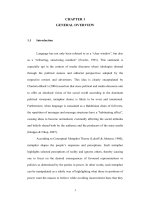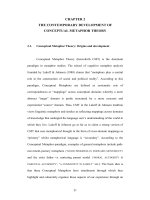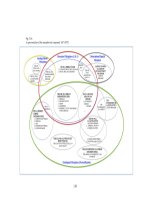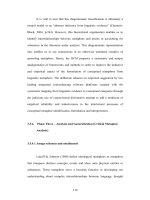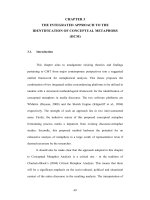Study of physico-chemical properties of soil and availability of nutrients in maize-wheat cropping sequence
Bạn đang xem bản rút gọn của tài liệu. Xem và tải ngay bản đầy đủ của tài liệu tại đây (262.94 KB, 10 trang )
Int.J.Curr.Microbiol.App.Sci (2019) 8(2): 1259-1268
International Journal of Current Microbiology and Applied Sciences
ISSN: 2319-7706 Volume 8 Number 02 (2019)
Journal homepage:
Original Research Article
/>
Study of Physico-Chemical Properties of Soil and Availability of Nutrients
in Maize-Wheat Cropping Sequence
S.C. Meena*, Bajrang Bali, Vishakha Bansa, Dharmendra Singh,
S.R. Meena and Mahendra Yadav
Department of Soil Science, Rajasthan College of Agriculture, MPUAT,
Udaipur, Rajasthan, India
*Corresponding author
ABSTRACT
Keywords
Physico-chemical,
Soil, Availability
and nutrients
Article Info
Accepted:
10 January 2019
Available Online:
10 February 2019
The present study was conducted to know the physico-chemical properties of soil and
availability of nutrients. It was observed that physico-chemical properties of soil
significantly influenced by various treatments. pH values varies from 8.18 to 8.30 during
2015-16 and 8.18 to 8.34 during 2016-17. It is evident from the data, the application of
150% NPK in treatment T11 significantly increases to 0.88 as compared to 0.84 under
control plot). A critical perusal of data indicate that the highest organic carbon 0.92 and
0.97 per cent was obtained during 2015-16 and 2016-17, respectively with application of
FYM 20 t ha-1. The bulk density varies from 1.30 to 1.42 Mg m-3 and 1.26 to 1.41 Mg m-3
during 2015-16 and 2016-17 under different treatments. The significantly maximum water
holding capacity was recorded (48.88, 49.00 and 48.94 %) with the application of FYM 20
t ha-1 (T12). The sand content of experimental plots ranged from 37.68 to 38.65 per cent
with a mean value of 38.11. The highest available nitrogen 457 and 453 kg ha -1, potassium
596 and 595 kg ha-1, sulphur 23.76 and 23.68 mg ha-1, DTPA extractable zinc 3.66 and
3.59 ppm, DTPA extractable iron 3.72, copper 2.52, 2.48 and 2.50 ppm was recorded by
application of 100% NPK + FYM 10 t ha-1 (T9) treatments and manganese 13.52 and 13.36
ppm were recorded.
Introduction
Indian agriculture is passing through a critical
phase. It is confounded with increasing crop
production, sustainability and environmental
quality issues. Answers to these questions can
be sought by the long-term experiments,
which are valuable repositories of information
regarding the sustainability of intensive
agriculture. Sustainability in crop production
has always been tough task. It requires a deep
knowledge and wisdom of pedo-edaphometeorological
interactions
under
investigation. Besides irrigation, nutrient
management is the single most important
factor affecting crop yields for the particular
genotype. It is more so in the intensive
cropping. Indian soils have become deficient
not only in major plant nutrients like nitrogen,
phosphorus and in some cases, potash but also
1259
Int.J.Curr.Microbiol.App.Sci (2019) 8(2): 1259-1268
in micronutrients such as zinc, boron and to a
limited extent iron, manganese, copper and
molybdenum have also been reported to be
deficient. Nitrogen occupies a unique position
among the elements essential for all plants
because of its large amounts requirement by
most agricultural crops and accounts for 1 to
4 per cent of dry matter in plants. The
available nitrogen status in soils increased
with increased supply of nitrogen in the form
of either fertilizers or organic manures which
ultimately increased the productivity of crop.
Transformation of added nitrogen through
fertilizers or manures into different forms of
nitrogen in soil and their availability to crops
depends on soil properties and nature of
nitrogen sources added to soils. Shilpashree et
al., (2012) study the effect of integrated
nutrient management practices on distribution
of nitrogen fractions in soil. Except inorganic
nitrogen fractions, organic nitrogen fractions
were recorded high in integrated treatments
compared to the treatment which received
nitrogen only in the form of fertilizers.
Materials and Methods
Results and Discussion
Physico-chemical properties of soil
An experiment of data in Table 1 to 6
revealed that physico-chemical properties of
soil significantly influenced by various
treatments. The significant influence on soil
properties was obtained by integrated
application of 10 t ha-1 FYM with
recommended dose of NPK during both years
of experimentation.
pH of soil
It is evident in data presented in Table 1 that
application
of
different
treatments
significantly influences the pH among
different treatments. pH values varies from
8.18 to 8.30 during 2015-16 and 8.18 to 8.34
during 2016-17. However the differences
were found statistically not significant.
Talashilkar et al., (2006) found that all the
fractions of nitrogen decreased with increase
in soil pH.
EC of soil
The present study was conducted at the
Instructional farm, Rajasthan College of
Agriculture, Udaipur during 2015-16 and
2016-17.
The experimental site is a
permanent manurial trial and its layout is on
fixed site, at block B2, situated at 24°34N'
latitude, 73°42E' longitude and 582.17 m
about mean sea level. The area comes under
sub-humid southern plain (Zone-IVa) of
Rajasthan. The climate of the region is
subtropical, characterized by mild winters and
distinct summers associated with high relative
humidity particularly during the months of
July to September. The mean annual rainfall
of the region varies from 650 to 750 mm,
most of which is received in rainy season
from July to September. The mean maximum
and minimum temperature are 35.45°C and
17.41°C, respectively.
Data pertaining to the effect of different
treatments on EC presented in Table 1. It is
evident from the data, the application of
150% NPK in treatment T11 significantly
increases to 0.88 as compared to 0.84 under
control plot. Application of 20 t ha-1 FYM
(T12) lowers the EC values significantly as
compared to control plot. Same trend was
observed
during
both
years
of
experimentation (Table 1).
Organic carbon of soil
Organic carbon contents after harvest of
wheat crop under maize-wheat cropping
sequence influenced significantly during both
years of experimentation at 0-15 cm depth
(Table 2). A critical perusal of data indicate
that the highest organic carbon 0.92 and 0.97
1260
Int.J.Curr.Microbiol.App.Sci (2019) 8(2): 1259-1268
per cent was obtained during 2015-16 and
2016-17, respectively with application of
FYM 20 t ha-1. This treatment was
significantly superior to other treatments
during both years under pooled analysis.
Other treatments also influenced organic
carbon content significantly as compared to
control plot.
Bulk density
Data presented in the Table 2 revealed that
the bulk density varies from 1.30 to 1.42 Mg
m-3 and 1.26 to 1.41 Mg m-3 during 2015-16
and 2016-17 under different treatments. The
bulk density significantly decreased 1.30 and
1.26 Mg m-3 during 2015-16 and 2016-17,
under FYM 20 t ha-1 application. This
treatment was at par with 100% NPK + FYM
10 t ha-1 (T9) and FYM 10 t ha-1 + 100% NPK
(-NPK of FYM) treatment (T10) during 201516 and 2016-17. The pooled data revealed
that application of FYM 20 t ha-1 gave lowest
bulk density i.e. 1.28 Mg m-3 and at par with
FYM 10 t ha-1 + 100% NPK (-NPK of FYM)
treatment (T10). This treatment gave 9.21 and
7.24 per cent less bulk density as compare to
control (1.41 Mg m-3) and recommended dose
of fertilizer (1.38 Mg m-3).
Water holding capacity
Data related to water holding capacity under
the influence of different treatment of
fertilizers and manures are presented in Table
3. Data revealed that the application of
different treatments differed significantly with
respect to water holding capacity of the
experimental soil during both the years and
pooled basis. The significantly maximum
water holding capacity was recorded (48.88,
49.00 and 48.94 %) with the application of
FYM 20 t ha-1 (T12) and at par with 100%
NPK + FYM 10 t ha-1 (T9) and FYM 10 t ha-1
+ 100% NPK (-NPK of FYM) treatment (T10)
during both the years 2015-16, 2016-17 and
in pooled.
Nutrients availability
Available nitrogen
The available nitrogen content varies from
252 to 457 kg ha-1 during 2015-16 and 201617 under dif����������������������������������������������������������������������������������������������������������������������������������������������������������������������������������������������������������������������������������������������������������������������������������������������������������������������������������������������������������������������������������������������������������������������������������������������������������������������������������������������������������������������������������������������������������������������������������������������������������������������������������������������������������������������������������������������������������������������������������������������������������������������������������������������������������������������������������������������������������������������������������������������������������������������������������������������������������������������������������������������������������������������������������������������������������������������������������������������������������������������������������������������������������������������������������������������������������������������������������������������������������������������������������������������������������������������������������������������������������������������������������������������������������������������������������������������������������������������������������������������������������������������������������������������������������������������������������������������������������������������������������������������������������������������������������������������������������������������������������������������������������������������������������������������������������������������������������������������������������������������������������������������������������������������������������������������������������������������������������������������������������������������������������������������������������������������������������������������������������������������������������������������������������������������������������������������������������������������������������������������������������������������������������������������������������������������������������������������������������������������������������������������������������������������������������������������������������������������������������������������������������������������������������������������������������������������������������������������������������������������������������������������������������������������������������������������������������������������������������������������������������������������������������������������������������������������������������������������������������������������������������������������������������������������������������������������������������������������������������������������������������������������������������������������������������������������������������������������������������������������������������������������������������������������������������������������������������������������������������������������������������������������������������������������������������������������������������������������������������������������������������������������������������������������������������������������������������������������������������������������������������������������������������������������������������������������������������������������������������������������������������������������������������������������������������������������������������������������������������������������������������������������������������������������������������������������������������������������������������������������������������������������������������������������������������������������������������������������������������������������������������������������������������������������������������������������������������������������������������������������������������������������������������������������������������������������������������������������������������������������������������������.08
0.62
C.D. (P = 0.05)
3.08
3.11
1.76
T1 = Control
1264
Int.J.Curr.Microbiol.App.Sci (2019) 8(2): 1259-1268
Table.4 Effect of fertilizers and manures on available N, P2O5, K2O (kg ha-1) and S (mg ha-1) after harvest of
wheat under maize –wheat cropping sequence
Treatments
Available N
Available P2O5
Available K2O
Available S
2015-16
2016-17
Pooled
2015-16
2016-17
Pooled
2015-16
2016-17
Pooled
2015-16
2016-17
Pooled
T1 = Control
254
252
253
15.76
15.90
15.83
479
478
478
15.73
15.72
15.73
T2 = 100% N
268
266
267
15.98
16.12
16.05
487
485
486
15.83
15.83
15.83
T3 = 100% NP
279
276
277
22.86
23.00
22.93
495
494
494
16.69
16.55
16.62
T4 = 100% NPK
348
345
346
24.64
24.78
24.71
553
552
553
17.49
17.45
17.47
T5 = 100% NPK + Zn
342
340
341
26.88
27.02
26.95
556
555
556
16.76
16.65
16.70
T6 = 100% NPK+ S
340
338
339
25.82
25.96
25.89
549
547
548
23.76
23.68
23.72
T7 = 100% NPK + Zn + S
343
339
341
25.42
25.56
25.49
562
561
562
23.64
23.58
23.61
T8 = 100% NPK + Azotobactor
355
351
353
24.68
24.82
24.75
576
575
576
16.81
16.72
16.77
T9 = 100% NPK + FYM 10 t
ha-1
T10 = FYM 10 t ha-1 + 100%
NPK (-NPK of FYM)
T11 = 150% NPK
457
453
455
30.24
30.38
30.31
595
593
594
18.34
18.25
18.30
403
399
401
26.98
27.12
27.05
584
583
584
18.05
17.98
18.02
358
354
356
27.85
28.00
27.93
596
595
596
17.42
17.37
17.40
T12 = FYM 20 t ha-1
368
364
366
23.56
23.27
23.42
580
579
580
19.15
19.07
19.11
S.Em.±
8.35
8.27
5.88
0.568
0.571
0.403
12.996
12.967
9.179
0.424
0.422
0.299
C.D. (P = 0.05)
24.03
23.80
16.60
1.635
1.644
1.138
37.394
37.309
25.919
1.219
1.215
0.844
1265
Int.J.Curr.Microbiol.App.Sci (2019) 8(2): 1259-1268
Table.5 Effect of fertilizers and manures on available Zn, Cu, Mn and Fe (ppm) after harvest of wheat
under maize –wheat cropping sequence
Treatments
Available Zn
Available Fe
Available Cu
Available Mn
2015-16
2016-17
Pooled
2015-16
2016-17
Pooled
2015-16
2016-17
Pooled
2015-16
2016-17
Pooled
T1 = Control
2.02
1.95
1.99
2.62
2.60
2.61
1.62
1.60
1.61
9.02
9.02
9.02
T2 = 100% N
2.18
2.11
2.15
2.69
2.62
2.66
1.61
1.61
1.61
9.72
9.67
9.70
T3 = 100% NP
2.48
2.41
2.44
3.08
2.95
3.01
1.92
1.89
1.90
9.46
9.36
9.41
T4 = 100% NPK
2.40
2.33
2.37
2.98
2.96
2.97
1.89
1.82
1.86
9.64
9.55
9.60
T5 = 100% NPK + Zn
3.66
3.59
3.62
3.16
3.08
3.12
2.12
2.05
2.08
9.76
9.70
9.73
T6 = 100% NPK+ S
2.42
2.35
2.39
3.32
3.26
3.29
2.22
2.20
2.21
10.26
10.14
10.20
T7 = 100% NPK+ Zn + S
3.62
3.55
3.59
3.48
3.38
3.43
2.18
2.18
2.18
11.06
10.78
10.92
T8 = 100% NPK + Azotobactor
2.52
2.45
2.48
3.28
3.24
3.26
1.72
1.68
1.70
11.04
10.88
10.96
T9 = 100% NPK + FYM 10 t
ha-1
T10 = FYM 10 t ha-1 + 100%
NPK (-NPK of FYM)
T11 = 150% NPK
3.48
3.41
3.45
3.72
3.66
3.69
2.52
2.48
2.50
12.94
12.65
12.80
3.42
3.35
3.39
3.56
3.48
3.52
2.46
2.44
2.45
12.76
12.48
12.62
2.44
2.37
2.41
2.89
2.82
2.86
1.78
1.72
1.75
9.46
9.34
9.40
T12 = FYM 20 t ha-1
2.72
2.65
2.69
2.98
2.88
2.93
2.32
2.28
2.30
13.52
13.36
13.44
S.Em.±
0.06
0.06
0.04
0.07
0.07
0.05
0.05
0.05
0.03
0.26
0.26
0.19
C.D. (P = 0.05)
0.19
0.19
0.13
0.22
0.21
0.15
0.14
0.14
0.09
0.76
0.76
0.53
1266
Int.J.Curr.Microbiol.App.Sci (2019) 8(2): 1259-1268
It was at par with FYM 20 t ha-1 (T12), FYM
10 t ha-1 + 100% NPK (-NPK of FYM, T10),
100% NPK + FYM 10 tha-1 (T9) and 100%
NPK + Zn (T5) treatments during both the
years and also in pooled analysis. The pooled
analysis reveals that this treatment gave 24.68
and 7.77 per cent higher available potassium
as compare to control (478 kg ha-1) and
recommended dose of fertilizer (553 kg ha-1).
Available sulphur
It was apparent from the data (Table 4) that
the highest available sulphur 23.76 and 23.68
mg ha-1 was recorded under 100% NPK+ S
treatment (T6) during 2015-16 and 2016-17,
respectively. It was at par with 100% NPK
+Zn+ S (T7), FYM 20 t ha-1(T12), FYM 10 t
ha-1 + 100% NPK (T9) and 100% NPK +
FYM 10 t ha-1 (– NPK of FYM) i.e.
T10treatmentsduring both the years and also in
pooled analysis. The pooled analysis reveals
that this treatment gave 50.79 and 35.77 per
cent higher available sulphur as compare to
control (15.73 mg ha-1) and recommended
dose of fertilizer (17.47 mg ha-1).
Available zinc
It was apparent from the data (Table 5) that
the highest DTPA extractable zinc 3.66 and
3.59 ppm was recorded at 100% NPK + Zn
(T5) treatment during 2015-16 and 2016-17,
respectively.
This treatments is closely followed and
statistically at par with 100% NPK + Zn +S
(T7), 100% NPK + FYM 10 t ha-1 (T9) and
FYM 10 t ha-1 + 100% NPK (-NPK of FYM)
(T10) treatments during both the years and
also in pooled analysis. The pooled analysis
reveals that this treatment gave 81.90 and
56.03 per cent higher available zinc as
compare to control (1.99 ppm) and
recommended dose of fertilizer (2.37 ppm).
Available iron
It was apparent from the data (Table 5) that
the highest DTPA extractable iron 3.72 and
3.66 ppm was recorded at 100% NPK + FYM
10 t ha-1 (T9) treatment during 2015-16 and
2016-17, respectively. It was at par with
100% NPK+ FYM 10 t ha-1 (-NPK of FYM,
T10) treatments during both the years and also
in pooled analysis. This both treatments were
significantly superior to all other treatments
during both years of experimentation and it
was also observed in pooled analysis. The
pooled analysis reveals that this treatment
gave 41.37 and 24.24 per cent higher
available iron as compare to control (2.61
ppm) and recommended dose of fertilizer
(2.97 ppm). Rao and Sitaramayya (1997)
indicated a significant correlation of nitrogen
uptake by rice with total and available
nitrogen forms at 45 and 60 DAT.
Available copper
Data pertaining to the available copper in soil
after completion of maize – wheat rotation as
effected by different treatment presented in
(Table 5). The highest available copper 2.52,
2.48 and 2.50 ppm was recorded by
application of 100% NPK + FYM 10 t ha-1
(T9) treatments during 2015-16, 2016-17 and
pooled analysis, respectively. This treatment
(T9) was at par with 100% NPK+ FYM 10 t
ha-1 (-NPK of FYM, T10) treatments during
both the years and also in pooled analysis.
This both treatments was found statistically
significant than other treatments during both
years of experimentation.
Available manganese
Pooled available manganese in the soil varies
from 9.02 to 13.44 ppm with different
treatments (Table 5). The highest manganese
13.52 and 13.36 ppm was recorded by
application of FYM @ 20 t ha-1 (T12)
1267
Int.J.Curr.Microbiol.App.Sci (2019) 8(2): 1259-1268
treatment during 2015-16 and 2016-17,
respectively. This treatment was found
superior
than
all
other
treatments
significantly. Data also indicated that either
application of NPK alone or with manures
treatments significantly improve manganese
content in soil.
References
Begum, M., Narayanasamy, G., Rai, R.K. and
Biswas, D.R. 2007. Influence of
integrated nutrient management on
nitrogen and phosphorus in soil under
wheat- mungbean-maize cropping
system. Journal of the Indian Society
of Soil Science, 55(1): 175-183.
Rao, S.S. and Sitaramayya, M. 1997. Changes
in total and available soil nitrogen
status under integrated nutrient
management of rice. Journal of the
Indian Society of Soil Science, 45(3):
445-449.
Shilpashree, V.M., Chidanandappa, H.M.,
Jayaprakash, R. and Punitha, B.C.
2012. Effect of integrated nutrient
management practices on distribution
of nitrogen fractions by maize crop in
soil. Indian Journal of Fundamental
and Applied Life Sciences, 2(1): 3844.
Talashilkar, S.C., Mehta, V.B., Dosani,
A.A.K., Dhopavkar, R.V. and
Dhekale, J.S. 2006. Influence of soil
reaction on soil acidity parameters,
and fractions of organic matter,
nitrogen, phosphorus and potassium in
laterite soils of Konkan. Journal of the
Indian Society of Soil Science, 54(2):
174-178.
How to cite this article:
Meena, S.C., Bajrang Bali, Vishakha Bansa, Dharmendra Singh, S.R. Meena and Mahendra
Yadav. 2019. Study of Physico-Chemical Properties of Soil and Availability of Nutrients in
Maize- Wheat Cropping Sequence. Int.J.Curr.Microbiol.App.Sci. 8(02): 1259-1268.
doi: />
1268
